Preston Tram Workshop
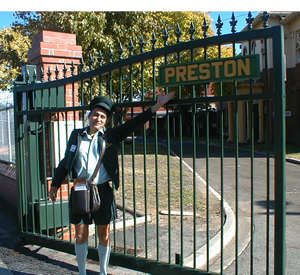 Roberto D'Andrea at the gates of the Preston Tram Workshop |
Life After MalcolmAtlantis Found in PrestonThere is still one major public asset that is yet to be privatised. On the corner of St George’s Road and Miller Street is the birthplace of Melbourne’s iconic W class tram fleet. The Preston tram workshop has been building and maintaining the city’s tram fleet since the 1920s. Today it is like an Atlantis in a world submerged by economic rationalism. What is its future? Entering the workshop today is like stepping back into the 1950s. Walls display the ornate MMTB symbol and signs quote imperial measures. Workers in beanies take a break to warm their hands over a pot-bellied stove. If called on, they could start building the W class trams again using all the original equipment, including a bench for silk-screening destination rolls and the original 1920s crane for lifting heritage vehicles. Sixteen acres of tram nirvana. On paper, the appeal of Preston may seem limited to ‘gunzels’ (tram enthusiasts). However, the long history of trams as Melbourne’s ‘urban theatre’ is reflected all around the site. The film that did most to celebrate this fanciful side of trams, Nadia Tass and David Parker’s Malcolm, had many of its scenes filmed in the workshop. There is a festive air about the place. The Tudor-style ‘Melbourne Room’ still features the gaily decorated stage that hosted 3DB’s Lunchtime Funtime with Bill Collins. The splendid series of ‘art trams’ and Moomba’s recent sensation Trams on Parade were all decorated in the paint shop. The man ordained by Nadia Tass as a ‘real Malcolm’, Norm Cross, still works here. As well as a walking encyclopaedia of trams, Norm embodies the comic spirit of the workshop. One of his roles as a fitter was to service the tram bells. He recalls one of his impromptu concerts. ‘I was playing a tune one day and the boss put his head out of the window and said, “That’s a lovely tune Norm, do you know how to play Tom Dooley?” I said “I can’t do it”, and he said “Well I’m sick of that bloody tune so shut up.”’ It is the kind of place where men can occasionally be boys. And trams can be people. Special treatment is given to ‘old 1041’, the 1973 proto-Z Class built totally in the workshop. 1041 broke down tragically on its official debut and remains the workshop’s Miss Haversham. Norm gives 1041 a pat and a chorus of happy birthday. Other veterans are still around. The superintendent is a waxen-haired Brian Carter, a regal kind of bloke who tries to hide his cheekiness with little success. One of Brian’s proudest achievements was to introduce artists into the workshop. He has a story for each of them. Cliff Pugh he recalls as ‘a hard man when he first came in, but then something happened and he was a good as gold’. Brian accompanies ‘something happens’ with a wiggle of thumb and forefinger to suggest that a trip the pub may have occurred. How did it escape the asset-stripping 1990s? Preston has been in the ‘too hard’ basket for a long time. As a unique asset in the transport system, it could not be sold off to either of the new private operators without granting one an unfair advantage over the other. Under competitive tendering, part of the workshop was given over to private maintenance business, but without experience in the field they did not last long (their legacy is the flawed braking system that has now put the W-class fleet out of action). Nevertheless, full privatisation seemed inexorable. While last year’s surprise change in government has granted the workshop a reprieve, its future is far from assured. What was once a workforce of nearly 700 is now down to less than 40. They have to compete for maintenance work against the depots owned in-house by Swanston and Yarra. In the big picture, they are a dinosaur of economic irrationalism. But in the small picture, they look pretty good. Preston is still the best equipped workshop for handling heritage trams. It has an assortment of cranes, transverses and practice tracks for moving trams around. From a historical perspective, it retains the templates and jigs for cutting body parts— the DNA of the city’s tram fleet. The workshop is almost certain to be registered with the National Trust. Expert on their industrial heritage committee, Gary Vines, ranks it with Flinders Street and #2 Goods Shed at Docklands in significance. He describes it as the ‘heart of the tram system’. However, the full value of Preston workshop goes beyond bricks and jigs. Transport consultants Booz Allen & Hamilton highlight the ‘intellectual capital’ possessed by ‘the trade skills of the Preston workforce’. Gary Vines agrees, ‘It’s really quite important to keep not just a building, but to retain the feeling about the place, like the skills and attitude.’ Part of that attitude is a commitment to the craft of tram maintenance. Ben Commandeur, a plucky cabinet-maker, is typical of the pride about the place. He reels off an endless list of skills that are maintained at Preston. Each has their own mysteries, like the boat-building techniques used to re-roof a W class tram. Tram activist Roberto D’Andrea sees the Preston workshop as an opportunity to ‘instil pride’ and ‘promote our culture of place’. He laments ‘We’ve had a dearth of good tram stories lately’ but hopes that the workshop might gain support from a state Labor government that is yet to find its legacy. If this were still the 1990s, then we would be serenading these gallant old-timers off into history. In Full Monty, Sheffield’s ex-steel workers had to sell themselves on the open market. The nineties taught us to forget welding and learn telemarketing. But the new century has started with an auspicious ‘market correction’. London’s new Lord Mayor has come to power on a promise to protect the Tube from privatisation. Even Sheffield has brought back human conductors to save its tram system. And they’ll be soon back in Melbourne, too. With a little 21st century hope in their hearts, workers have put together a proposal for a tram museum. Currently before government is a plan to turn the unused buildings into displays from major tram collections currently awaiting a home. One of the main museum assets, of course, is the workers. As a living tram museum, visitors would witness industrial crafts in action. With enough support, the Preston Tram workshop could provide Melbourne with a tourist attraction to rival the Philip Island penguin parade. Visitors would see W Class trams emerging from the dusk, a Leunig tram floating through the air, a Mirka Moira trundling along the practice track. It would be a Jurassic Park of the mechanical age. Poets would be commissioned to compose works for destination scrolls. You could even see men working. And visitors would leave Preston, pleased at the thought they had made pilgrimage to the place where Melbourne’s suburbs were born. Will the new century remember the quaint workshop that economic rationalism forgot?
Kevin Murray |
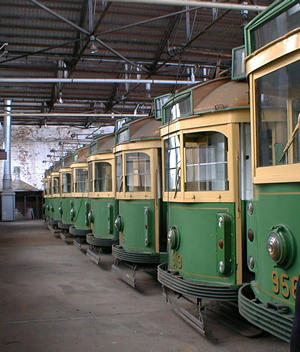 A fleet of W Class trams in the body workshop |
|
 A couple of workers attacking a bogey from underground |
|
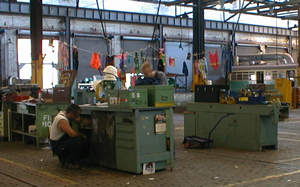 In the functioning workshop decorated from bathing costumes from the recent Moomba parade |
|
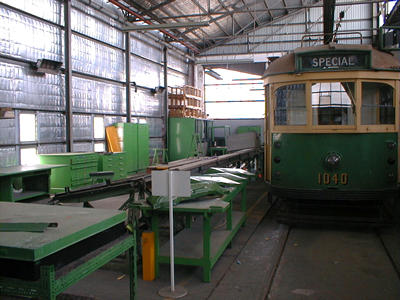 Tram destination rolls workshop |
|
 Desk in workshop |
|
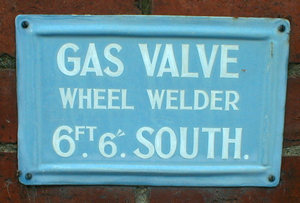 |
|
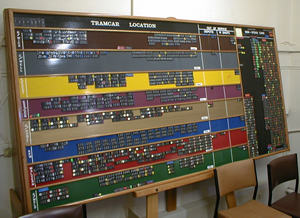 |
|
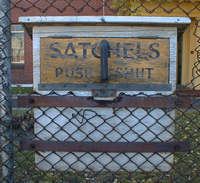 |
|
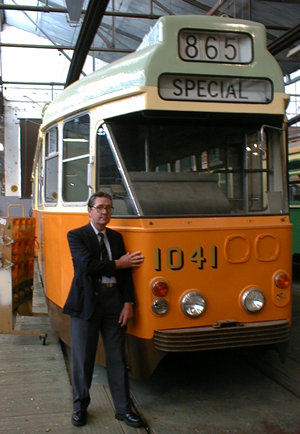 Norman Cross, prime tram consultant for the film Malcolm, with the tram he helped build on its 27th birthday |
|
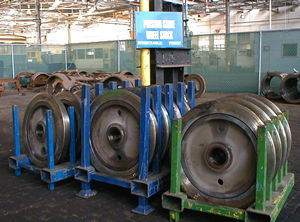 Tram wheels |
|
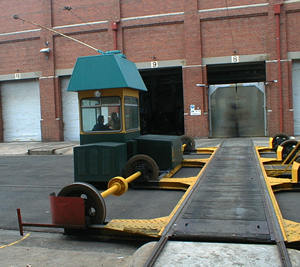 Traversal system for linking workshops |
|
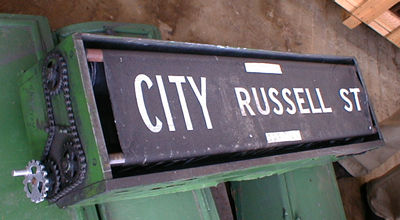 Destination roll |
|
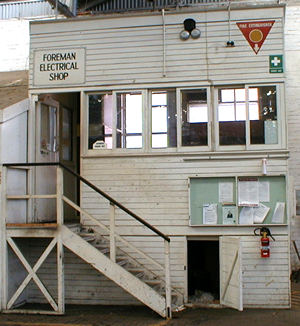 Old-fashioned industrial relations |
|
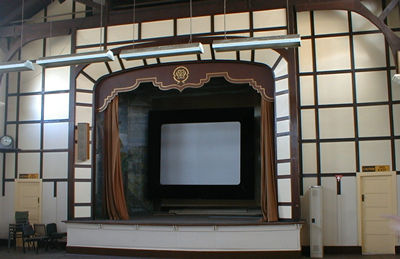 Stage in hall where workers used to eat and occasionally be entertained by live radio broadcasts |
Contact 'I prefer a tram conductor' at cordpull@hotmail.com